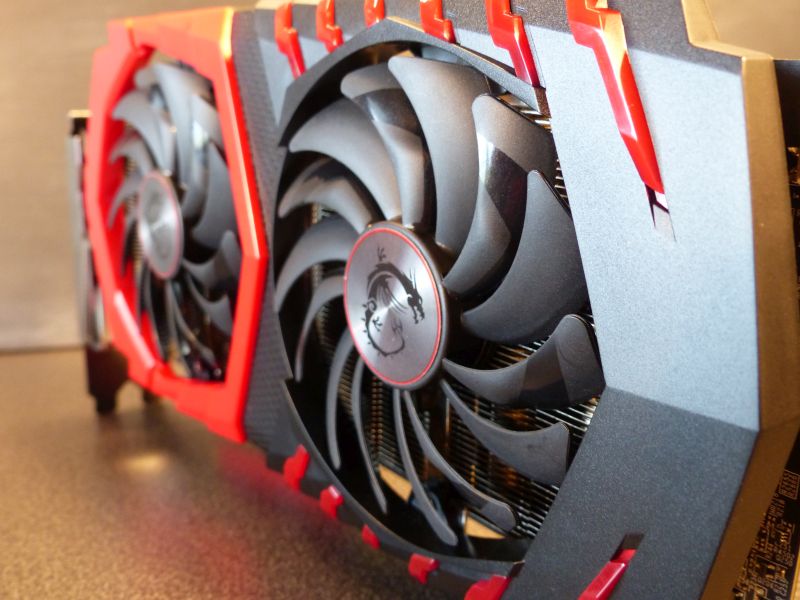Today, a one-page review of the MSI Radeon RX 470 Gaming X 8GB graphics card.
Article index:
1 – Overview
Finally I could plug in my testbed a member of the Radeon RX 400 family. It was time, because the GPU monitoring code used in current versions of FurMark, GPU Caps Viewer or GPU Shark doesn’t support AMD’s RX 400 GPUs. Now it’s fixed, thank you MSI!
The Radeon RX 470 has been launched about three weeks ago and is based on AMD’s Polaris GPU architecture (14nm FinFET process). The RX 470 is based on the Polaris 10 GPU which is also codenamed Ellesmere (the name of an island in the Northern Canada). The Polaris 10 GPU that boosts the RX 470 packs 2048 shader cores (32 compute units), 32 ROPs, 128 TMUs and works at 1206MHz (boost clock). The RX 470 is available in two flavors: the first one with 4GB of VRAM and the second one with 8GB of VRAM. MSI sent me the 8GB GDDR5 version. The memory is clocked at 1650MHz.
MSI RX 470 Gaming X is a factory-overclocked graphics card: the GPU runs at 1242MHz (gaming mode) or 1254MHz (OC mode). There is also an silent mode: 1206MHz with is the reference board clock speed. The graphics memory is not overclocked: the 8GB GDDR5 run at 1650MHz.
Links:
– MSI Radeon RX 470 Gaming X 8GB homepage
– AMD Radeon RX 470 homepage

2 – Gallery
Let’s start with the box and the bundle, if we can call it a bundle: the graphics card, a CDROM with driver and utilities and a user’s guide.
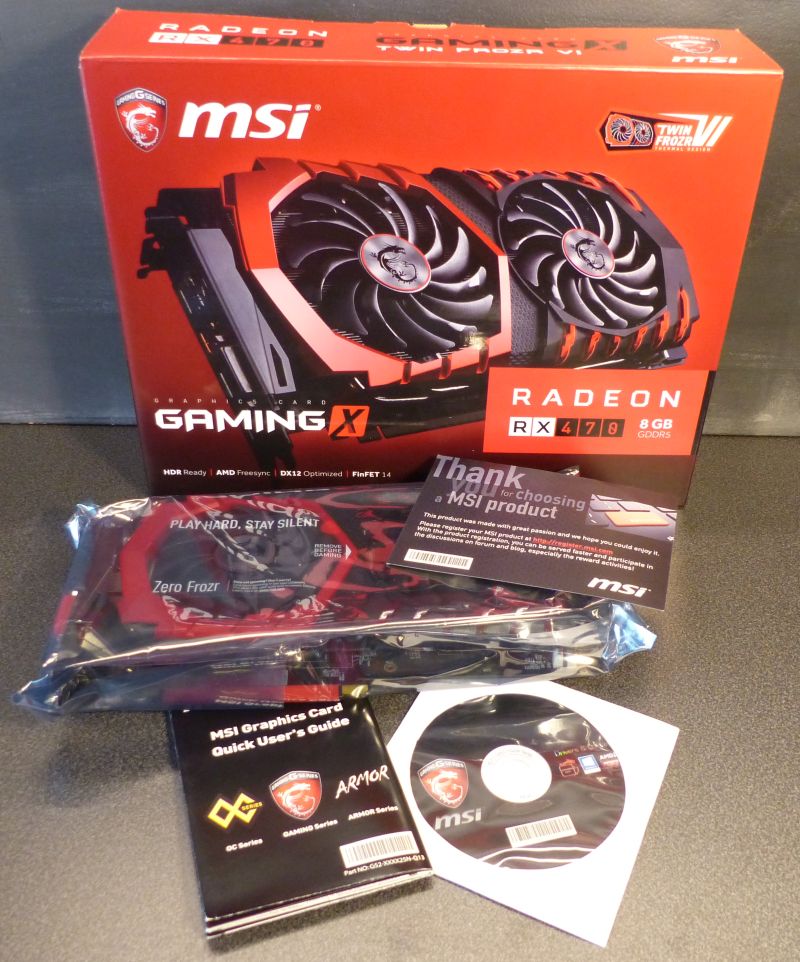
Now the graphics card!
I like the black/red VGA cooler. It’s based on MSI’s Twin FROZR VI cooling system. At idle (or when GPU temperature is less than 60°C), the fans do not spin (Zero Frozr technology): the graphics card is in passive/silent mode and is noiseless. Great!
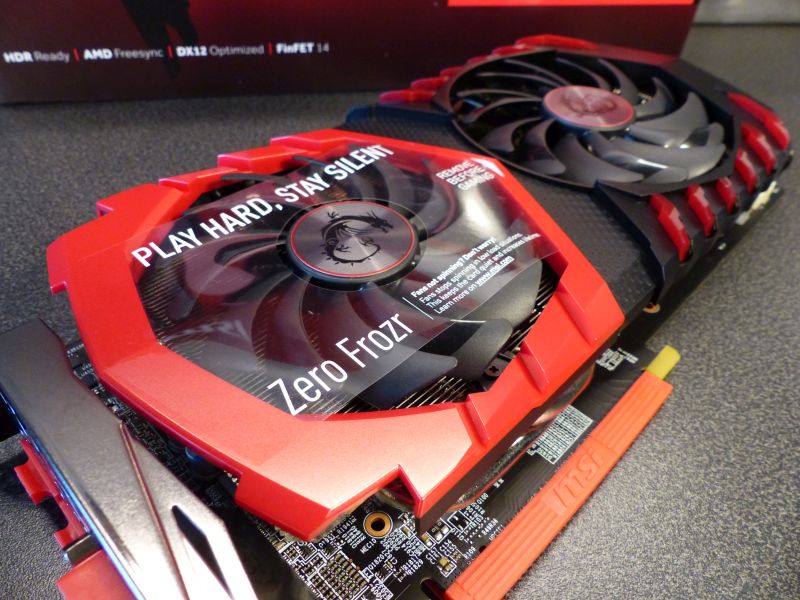
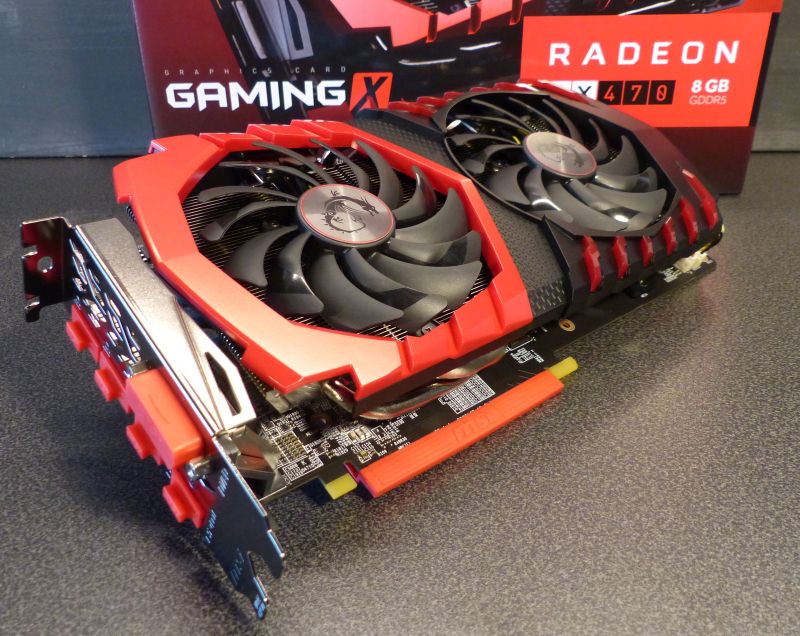
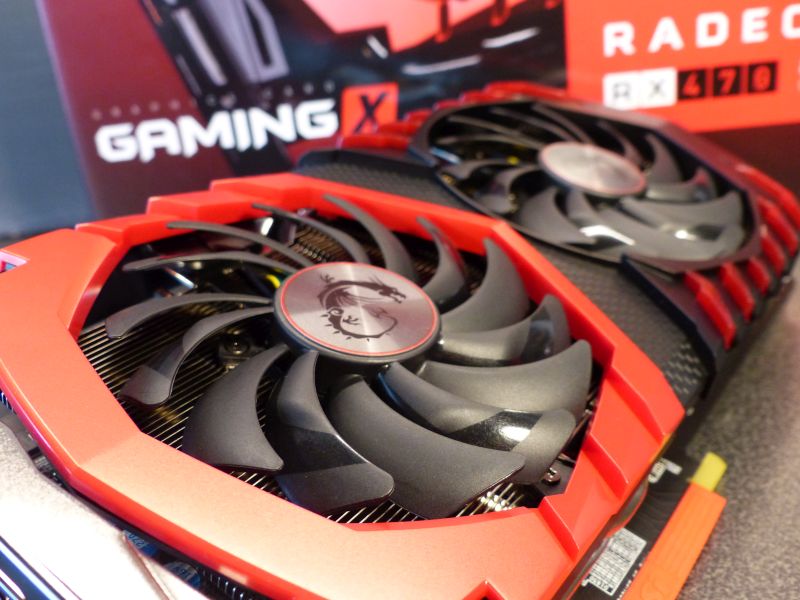
Thanks to an application, you can control the lighting effects of the VGA cooler shroud:
Each LED can be controlled individually by choosing any of the animation effects availiable in the MSI Gaming App, ranging from responding to your game sounds or music to steady light, breathing and flashing. Of course, you can also turn them off.


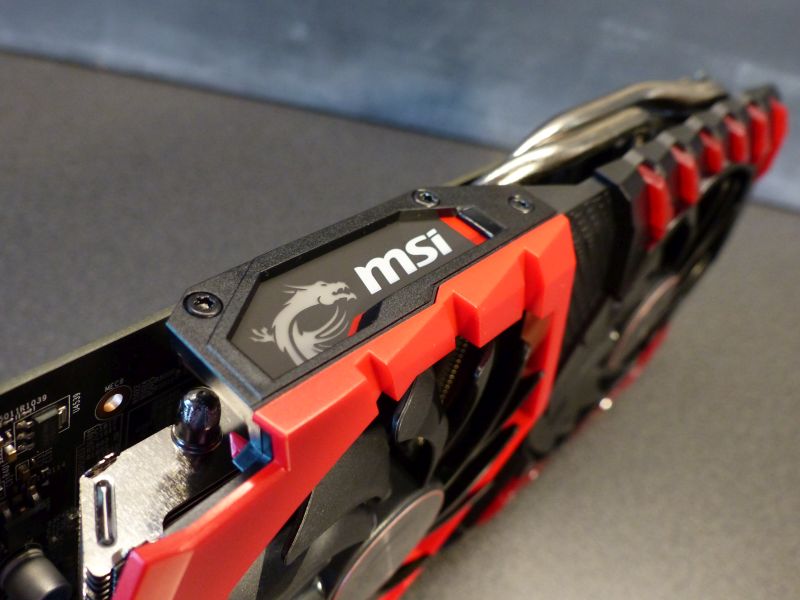
The RX 470 comes with one 8-pin power connector. A 8-pin power connector can supply up to 150W. The PCIe slot can supply up to 75W. That leads to a total power of 225W. The RX 470 reference board has a TDP of 120W. Hum… We’ll focus on this power in the burn-in section.

No backplate for the RX 470 Gaming X. Why? This card seems a bit fragile when you handle it, and really needs a backplate to make it more robust.
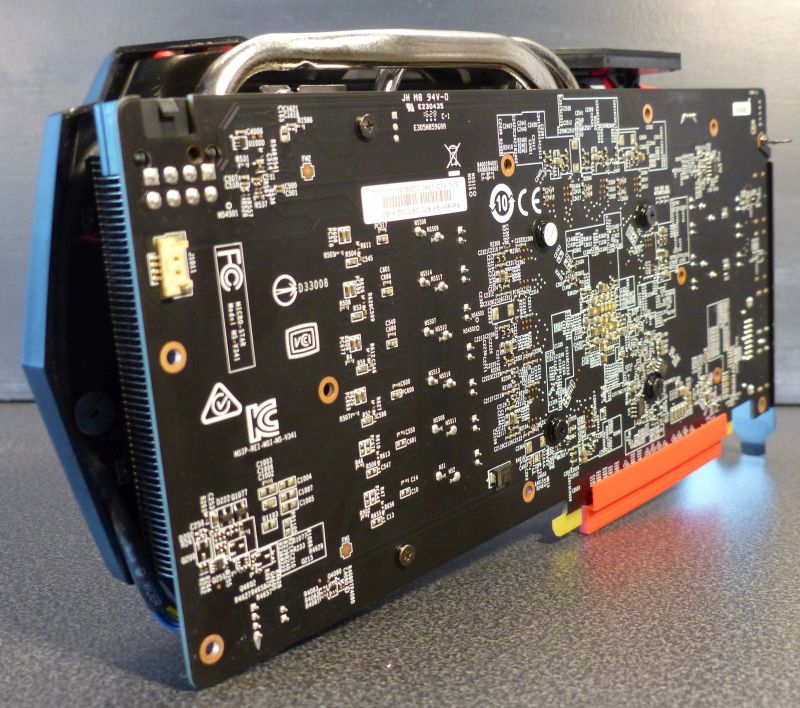
The RX 470 is equipped with two DisplayPort 1.4 connectors, two HDMI 2.0 connectors and one DVI connector:
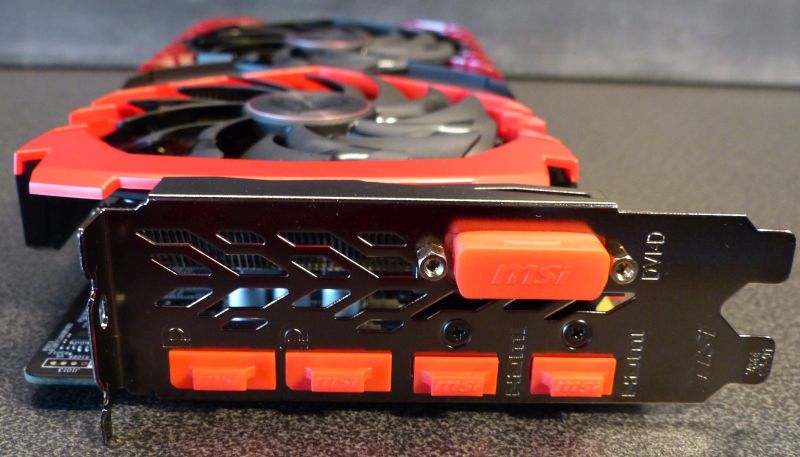
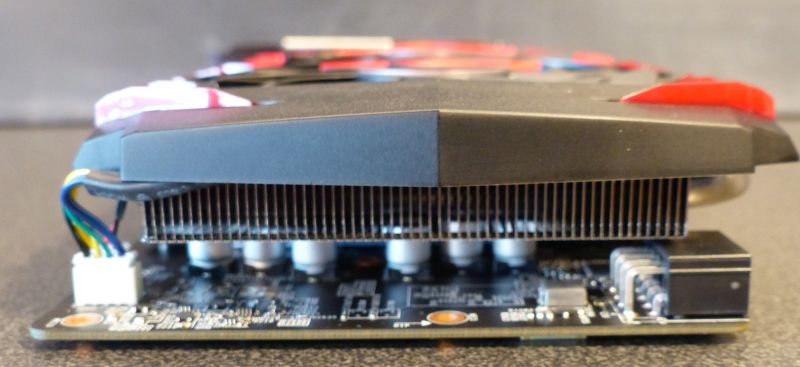
The RX 470 compared to the R9 290X:

3 – GPU Info
Tools: GPU Caps Viewer 1.31.0.0, GPU Shark 0.9.10, GPU-Z 1.10.

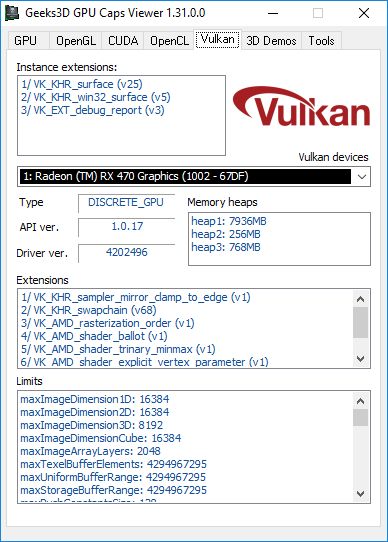

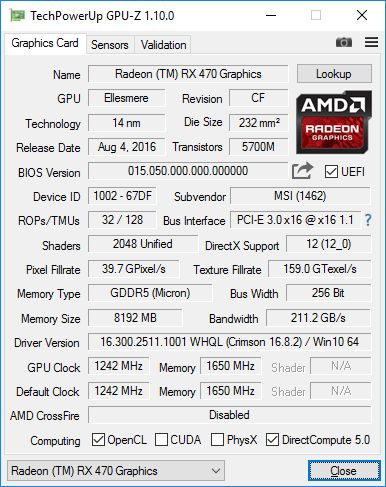

4 – Benchmarks
Testbed:
– motherboard: ASUS Z170 Gaming Pro
– CPU: Intel Core i5 6600K (default clock speed)
– PSU: Corsair AX860i
– memory: 16GB DDR4 Corsair Vengeance
4.1 – 3DMark Sky Diver
| 29024 – ASUS GeForce GTX 1080 Strix – R368.51 |
| 25134 – ASUS GeForce GTX 980 Ti – R353.06 |
| 24010 – MSI Radeon RX 470 Gaming X – Crimson 16.8.2 |
| 23451 – EVGA GeForce GTX 1060 SC – R368.81 |
| 23038 – ASUS GeForce GTX 980 Strix – R344.75 |
| 21964 – MSI Radeon R9 290X Gaming – Catalyst 14.9 WHQL |
| 21811 – Gainward GeForce GTX 970 Phantom – R344.75 |
| 20274 – EVGA GeForce GTX 780 – R344.75 |
| 17570 – MSI Radeon HD 7970 – Catalyst 14.9 WHQL |
| 17533 – EVGA GeForce GTX 680 – R344.75 |
4.2 – 3DMark Fire Strike
Fire Strike is a Direct3D 11 benchmark for high-performance gaming PCs with serious graphics cards.
| 15583 – ASUS GeForce GTX 1080 Strix – R368.51 |
| 12514 – ASUS GeForce GTX 980 Ti – R353.06 |
| 10574 – ASUS GeForce GTX 980 Strix – R344.75 |
| 10322 – EVGA GeForce GTX 1060 SC – R368.81 |
| 9741 – MSI Radeon RX 470 Gaming X – Crimson 16.8.2 |
| 9382 – MSI Radeon R9 290X Gaming – Catalyst 14.9 WHQL |
| 8870 – MSI GTX 970 CLASSIC 4GD5T OC – R344.75 |
| 8203 – EVGA GeForce GTX 780 – R344.75 |
| 6572 – MSI Radeon HD 7970 – Catalyst 14.9 WHQL |
| 6399 – ASUS Strix GTX 960 DC2 OC 4GB – R353.06 |
| 6235 – EVGA GeForce GTX 680 – R344.75 |
4.3 – 3DMark Fire Strike Ultra
| 5125 (Graphics score: 5330) – ASUS GeForce GTX 1080 Strix – R368.51 |
| 3047 (Graphics score: 3043) – EVGA GeForce GTX 1060 SC – R368.81 |
| 2628 (Graphics score: 2619) – MSI Radeon RX 470 Gaming X – Crimson 16.8.2 |
| 2617 (Graphics score: 2592) – MSI GTX 970 CLASSIC 4GD5T OC – R368.69 |
| 2178 (Graphics score: 2134) – EVGA GeForce GTX 780 – R368.69 |
4.4 – 3DMark Time Spy
| 6393 (Graphics score: 7449) – ASUS GeForce GTX 1080 Strix – R372.54 |
| 4177 (Graphics score: 4274) – EVGA GeForce GTX 1060 SC – R368.81 |
| 3658 (Graphics score: 3640) – MSI Radeon RX 470 Gaming X – Crimson 16.8.2 |
| 3410 (Graphics score: 3382) – MSI GTX 970 CLASSIC 4GD5T OC – R368.69 |
4.5 – FurMark 1.18
FurMark is an OpenGL 2 benchmark that renders a furry donut. This benchmark is known for its extreme GPU workload.
Settings: Preset:1080 (1920×1080)
| 7151 points (119 FPS) – ASUS GeForce GTX 1080 Strix – R368.51 |
| 6233 points (103 FPS) – ASUS GeForce GTX 980 Ti – R353.06 |
| 4660 points (77 FPS) – ASUS GeForce GTX 980 Strix – R344.75 |
| 4592 points (76 FPS) – MSI Radeon R9 290X Gaming – Catalyst 14.9 WHQL |
| 4578 points (76 FPS) – EVGA GeForce GTX 1060 SC – R368.81 |
| 4050 points (67 FPS) – EVGA GeForce GTX 780 – R344.75 |
| 3942 points (66 FPS) – MSI Radeon RX 470 Gaming X – Crimson 16.8.2 |
| 3335 points (55 FPS) – MSI GTX 970 CLASSIC 4GD5T OC – R344.75 |
| 2951 points (49 FPS) – MSI Radeon HD 7970 – Catalyst 14.9 WHQL |
| 2733 points (45 FPS) – EVGA GeForce GTX 680 – R344.75 |
| 2566 points (42 FPS) – ASUS Strix GTX 960 DC2 OC 4GB – R353.06 |
Settings: Preset:2160 (3840×2160)
| 2715 points (45 FPS) – ASUS GeForce GTX 1080 Strix – R368.51 |
| 1565 points (26 FPS) – EVGA GeForce GTX 1060 SC – R368.81 |
| 1385 points (23 FPS) – EVGA GeForce GTX 780 – R368.69 |
| 1353 points (23 FPS) – MSI Radeon RX 470 Gaming X – Crimson 16.8.2 |
| 1339 points (22 FPS) – MSI GTX 970 CLASSIC 4GD5T OC – R368.69 |
4.6 – Alien vs Predator
Alien vs Predator (or AvP) is a Direct3D 11 benchmark with tessellation and high quality shadows. AvP can be downloaded from this page.

Settings: Resolution: 1920 x 1080, Texture Quality: 2, Shadow Quality: 3, Anisotropic Filtering: 16, SSAO: ON, Vertical Sync: OFF, DX11 Tessellation: ON, DX11 Advanced Shadows: ON, DX11 MSAA Samples: 1.
| 305 FPS – ASUS GeForce GTX 1080 Strix – R368.51 |
| 229 FPS – ASUS GeForce GTX 980 Ti – R353.06 |
| 180.3 FPS – ASUS GeForce GTX 980 Strix – R344.75 |
| 176.3 FPS – EVGA GeForce GTX 1060 SC – R368.81 |
| 159.9 FPS – Gainward GeForce GTX 970 Phantom – R344.75 |
| 151.5 FPS – MSI GTX 970 CLASSIC 4GD5T OC – R344.75 |
| 147.8 FPS – MSI Radeon R9 290X Gaming – Catalyst 14.9 WHQL |
| 138 FPS – EVGA GeForce GTX 780 – R344.75 |
| 121.5 FPS – MSI Radeon RX 470 Gaming X – Crimson 16.8.2 |
| 103.1 FPS – EVGA GeForce GTX 680 – R344.75 |
| 102.6 FPS – MSI Radeon HD 7970 – Catalyst 14.9 WHQL |
| 97.8 FPS – ASUS Strix GTX 960 DC2 OC 4GB – R353.06 |
4.7 – Resident Evil 6 Benchmark
Resident Evil 6 (RE6) is a Direct3D 9 benchmark. RE6 benchmark can be downloaded from this page.

Settings: Resolution: 1920 x 1080, anti-aliasing: FXAA3HQ, all params to high.
| 21410 points – ASUS GeForce GTX 1080 Strix – R372.54 |
| 18527 points – EVGA GeForce GTX 1060 SC – R372.54 |
| 16332 points – MSI GTX 970 Classic – R353.06 |
| 14522 points – MSI Radeon R9 290X Gaming 4GB – Crimson 16.8.2 |
| 13789 points – MSI Radeon RX 470 Gaming X 8GB – Crimson 16.8.2 |
| 13405 points – EVGA GTX 780 – R353.06 |
| 11935 points – ASUS Strix GTX 960 DC2 OC 4GB – R353.06 |
| 11442 points – EVGA GTX 680 – R353.06 |
| 8794 points – MSI GTX 660 Hawk – R353.06 |
| 5714 points – ASUS GTX 750 + R353.06 |
| 4495 points – ASUS G551Jw notebook w/ GTX 960M 4GB + R353.06 |
4.8 – Unigine Valley 1.0
Unigine Valley is a Direct3D/OpenGL benchmark from the same dev team than Unigine Heaven. More information can be found HERE and HERE.

Settings: Extreme HD (Direct3D, 1920×1080 fullscreen, 8X MSAA)
| 102.0 FPS, Score: 4269 – ASUS GeForce GTX 1080 Strix – R372.54 |
| 86.1 FPS, Score: 3602 – ASUS GeForce GTX 980 Ti – R353.06 |
| 68.0 FPS, Score: 2846 – EVGA GeForce GTX 1060 SC – R372.54 |
| 67.8 FPS, Score: 2837 – ASUS GeForce GTX 980 Strix – R344.75 |
| 63.3 FPS, Score: 2648 – MSI Radeon R9 290X Gaming – Crimson 16.8.2 |
| 58.7 FPS, Score: 2457 – Gainward GeForce GTX 970 Phantom – R344.75 |
| 57.8 FPS, Score: 2418 – EVGA GeForce GTX 780 – R344.75 |
| 56.0 FPS, Score: 2344 – MSI GTX 970 CLASSIC 4GD5T OC – R344.75 |
| 46.4 FPS, Score: 1942 – MSI Radeon RX 470 Gaming X 8GB – Crimson 16.8.2 |
| 42.9 FPS, Score: 1796 – EVGA GeForce GTX 680 – R344.75 |
| 39.9 FPS, Score: 1668 – MSI Radeon HD 7970 – Catalyst 14.9 WHQL |
| 35.8 FPS, Score: 1500 – ASUS Strix GTX 960 DC2 OC 4GB – R353.06 |
| 34.6 FPS, Score: 1446 – EVGA GeForce GTX 580 – R344.75 |
| 32.4 FPS, Score: 1358 – MSI GTX 660 Hawk – R353.06 |
| 29.3 FPS, Score: 1224 – Sapphire Radeon HD 6970 – Catalyst 14.9 WHQL |
| 25.6 FPS, Score: 1071 – EVGA GeForce GTX 480 – R344.75 |
| 19.4 FPS, Score: 812 – ASUS GeForce GTX 750 – R344.75 |
| 16.2 FPS, Score: 679 – ASUS Radeon HD 7770 DC – Catalyst 14.9 WHQL |
5 – Burn-in Test

This quick burn-in test has been done with Geeks3D FurMark 1.18.
Testbed:
– motherboard: ASUS Z170 Gaming Pro
– CPU: Intel Core i5 6600K (default clock speed)
– PSU: Corsair AX860i
– memory: 8GB DDR4 Corsair Vengeance LPX @ 2666MHz
At idle, the total power consumption of the system was 46W and the GPU temperature was 39°C. And the noise? At idle, the MSI RX 470 is extremely quiet, or better, the card is noiseless (fans are stopped most of time thanks to the Zero FROZR technology).
I launched FurMark in stress test mode in 1280×720 and after 5 minutes, the GPU temperature reached 74°C while the total power consumption jumped to 286W.
A rough approximation of the RX 470 power consumption is (the power consumption of the CPU is around 20W when running FurMark): (286-46-20) * 0.9 = 198W
where 0.9 the the power efficiency factor of the Corsair AX860i PSU.
The RX 470 reference board has a TDP of 120W (100% TDP). With a TDP of 120W, one 6-pin power connector is enough. But MSI has selected a 8-pin power connector. A 8-pin connector can handle up to 150W and the total power draw of the board can reach 150+75 = 225W. So I think that these 198W are not too far from the real power consumption… My result is also confirmed by W1zzard’s RX 480 review at TechPowerUp.
At 74°C, the fan noise was barely audible. MSI has one of the best VGA cooler!
Here is the thermal imaging at idle:
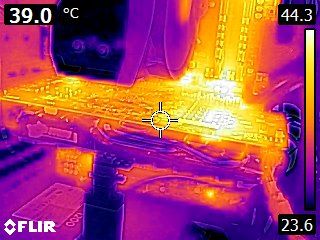
and the the thermal imaging under full stress (FurMark):
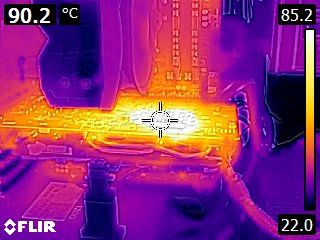
6 – Conclusion
With 3DMark, the RX 470 competes with the GTX 1060. On other tests, the RX 470 is between the GTX 960 and the GTX 970.
The VGA cooler is nice with its black and red colors, and does an admirable job: the card is extremely quiet while keeping low temperature. In idle or light 3D situations, fans are stopped and the card is simply noiseless. Under stress test, fans spin but the noise is barely audible. MSI Twin Frozr VI VGA cooler is just fantastic!
The power consumption of the RX 470 (around 200W) is a bit high especially if we compare it to the TDP of the RX 470 reference board (120W). But MSI has managed this power greedy GPU with a 8-pin power connector, so everything is under control. I don’t know if it’s related to the power consumption or not, but the testbed has suffered from several freezes (no more image on the display but still a video signal). Each time, a hard reboot was the only solution.
I never had such freezes with the other graphics cards, only with the RX 470. I hope it’s only related to this particular sample.
If we forget this minor issue, this RX 470 has nice features: great looking card with its black/red VGA cooler, two DisplayPort 1.4 and two HDMI 2.0 ports (for 4K resolution on UHD TVs), 8GB of GDDR5 memory, Zero Frozr technology for very quiet working (one of the fundamental features for me), customizable lighting.
The lack of backplate and the power issue I talked previously are the weakest points. Otherwise, the MSI RX 470 Gaming X 8GB is a great product.
Here are some prices found on Newegg.com:
– MSI RX 470 Gaming X 8GB: USD $239
– MSI RX 470 Gaming X 4GB: $199
– MSI RX 480 Gaming X 4GB: $249
– MSI RX 480 Gaming X 8GB: $289
– MSI GTX 1060 Gaming 3GB: $234
